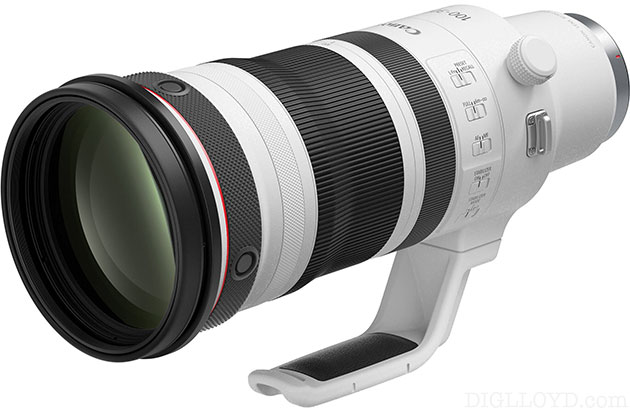Canon RF 100-300mm f/2.8L IS USM: the Most Useful Super Telephoto Yet?
re: Canon mirrorless

I’ve used various 300mm f/2.8 lenses over the years. They are very enjoyable in terms of telephoto compression and background blur. Invariably razor sharp, but a single fixed focal length is extremely limiting and frustrating if the subject is moving near/far.
With the Canon RF 100-300mm f/2.8L IS USM, Canon hits what I consider a sweet spot range yet with fast lens speed with the expectation of reference-grade image quality.
Clearly the design goal was high-end professional use; the f/2.8 aperture and the nice used-car price speak to that. I expect nothing less than superb performance from it. Sony will have to respond to this offering, but it will take years most likely.
At this point, Canon’s long lens offerings are unbeatable vs its competitors. And given the cost of the super-teles, the camera is an accessory.
The lens tripod foot design is problematic to the point of incompetent; it encourages and amplifies see-saw vibrations, easily seen in Live View. The last good tripod foot design was the Nikon 50-300mm f/4.5, which had a blocky snug lens foot, unbeatable by any modern design.
Reader Roy P writes:
Zero doubts that Sony (and Nikon) will have to come out with one of their own, or they will lose sales.
If you remember, Sigma used to make a Sigma 120-300mm f/2.8 DG OS HSM for a long time. It was a typical Sigma behemoth weighing 7.5 lbs for the “Sports” version that cost close to $3K and something like 5-6 lbs for the “Contemporary” version that cost around $1000. The main problem with this lens was, the zoom was not internal, so it was very tough to use it, even with a gimbal.
This Canon 100-300 looks like a very impressive lens. Unfortunately, using this lens also means having to buy a Canon camera, and that probably means an EOS R5 for $3900 (on sale for $3700 now), and the superb Canon 1.4x III for $430, so it ends up being a big investment of $14.3-14.5K.
It would be an impressive configuration for a set of use cases, but it’s too much investment into this one set up, so it can be rationalized only if you’re making a larger switch to Canon as your primary systems, and planning to get a few more Canon RF lenses, e.g., the 70-200 f/2.8 RF, and a second Canon body, maybe a future all-mirrorless 1DX IV.
For the past 25-30 years, Canon has owned the long focal length segment of photography, with Nikon a distant second. You can see football games from the 1990s until now and spot photographers on the sidelines with mostly white lenses, with a few black (Nikon) lenses here and there. Most of the NatGeo wildlife photographers have been Canon users.
For a brief moment in time, with the launch of the A9 and the staggering (at that time) 20 fps frame rate with no blackouts and continuous autofocusing in video, Sony had a chance to make a major dent into Canon’s market share, but Sony totally failed to understand this market. What these photographers needed was a rugged A9 that looked more like a Canon 1DX or Nikon D4/D5, with a bigger and more rugged body that could be dropped from a height of 6 feet and still work flawlessly, fully weather-sealed, with an integrated grip, ability to hold two oversized dual batteries, etc., along with the 400 f/2.8 and a couple of more long lenses to follow.
Amazingly, Sony had a 3-5 year window to take over a big chunk of this market, but blew it. You can see Canon has now fully consolidated its market share in pro sports and wildlife photography, and the only remaining cherry on top of the cake Canon needs is the mirrorless version of the 1DX, which would be the pro-grade equivalent of the Sony A1.
The Sony A9 came out around this time in 2017, and surprisingly, Canon rolled out the 1DX III in mid-2020, still staying with the DSLR! That certainly took a lot of guts – clearly, Canon felt very confident about the investments in glass its pro market has made. I think Sony’s last chance was with the A1, which they came out with in March 2021, and they blew it with yet another camera with the same form factor as the A7/A9 cameras.
Surely, Canon must be working on a 1DX IV that is all mirrorless, probably with a 40-50 MP sensor with a fast 24 MP mode for pro sports, 30 fps, all kinds of AI-based autofocusing goodies, etc., essentially a Sony A1 II in a 1DX packaging, and that will pretty much consolidate Canon’s hold on the action photography segment for a very long time.
DIGLLOYD: spot-on.
Reader Dave S writes:
I have to tell you many pro sports, and I am not talking about AP guys who had to change, have switched to Sony on their own
It amazes me when I got to MLB or NFL games how many have switched. Hell the Dodgers photographer even shoots his night games with the 200-600 sony lens on his A1 . I dont know as much about Wildlife guys. though I do know a few living in Idaho and some of them have changed as well. Sony has made a huge dent in the sports photography world, much larger then, I could have imagined a few years ago when I changed.
When I got to MLB games or NFL games, roughly half the photographers are shooting Sony, then Canon then Nikon. Now minor l;ague baseball games is more for ego for the photogrpahers and there are less Sony and usually I am the only one shooting mirrorless.
DIGLLOYD: sure, I’d bet that some photographers have switched, especially when the Sony A1 appeared. I don’t know what a “dent” means, but it implies small, is that 10%, 50%, what? My impression is that the market as a whole remains dominated by Canon. It used to be one could differentiate Canon lenses by color (off-white) but Sony has gone the same, can one see at a distance which is which? I thought I had seen metrics showing Canon dominance.
At any rate, Canon’s lens line is the most compelling for a pro sports photographer. The camera... I presume that both are highly competent but how well each works for any particular situation would take a pro sports photographer to be sure of.


















































